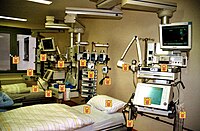
Photo from wikipedia
BACKGROUND Hospital-acquired pressure injuries are a serious problem among critical care patients. Although most hospital-acquired pressure injuries are stage 2 (partial-thickness skin loss with exposed dermis), no studies have examined… Click to show full abstract
BACKGROUND Hospital-acquired pressure injuries are a serious problem among critical care patients. Although most hospital-acquired pressure injuries are stage 2 (partial-thickness skin loss with exposed dermis), no studies have examined outcomes of stage 2 pressure injuries among critical care patients. OBJECTIVES To examine outcomes of stage 2 hospital-acquired pressure injuries among critical care patients and identify factors associated with nonhealing stage 2 hospital-acquired pressure injuries. METHODS Electronic health record data were used to identify surgical critical care patients with stage 2 hospital-acquired pressure injuries at a level I trauma center. Univariate Cox regressions were used to identify factors associated with healed stage 2 hospital-acquired pressure injuries. RESULTS Of 6376 surgical critical care patients, 298 (4.7%) developed stage 2 hospital-acquired pressure injuries; complete data were available for 253 patients. Of these 253 patients, 160 (63%) had unhealed pressure injuries at hospital discharge. Factors inversely related to the presence of a healed hospital-acquired pressure injury were older age (hazard ratio, 0.98; 95% CI, 0.97-0.99; P = .003), elevated serum lactate (hazard ratio, 0.85; 95% CI, 0.75-0.96; P = .01), elevated serum creatinine (hazard ratio, 0.87; 95% CI, 0.77-0.98; P = .02), and lower oxygenation (hazard ratio, 0.64; 95% CI, 0.41-1.00; P = .05). CONCLUSIONS Stage 2 hospital-acquired pressure injuries were not healed at discharge in 63% of the patients in our sample. Nurses should be especially vigilant in treating pressure injury patients who are older, have altered oxygenation or perfusion (elevated serum lactate level or decreased oxygenation), or have evidence of renal compromise.
Journal Title: Critical care nurse
Year Published: 2019
Link to full text (if available)
Share on Social Media: Sign Up to like & get
recommendations!